A two-day Private Tour in the Brecks. We were forecast a couple of days of good weather and so it proved. It almost didn’t seem like mid February at times! It was a great time to be out and about birdwatching in the Brecks.
Thursday 15th February
There was still a bit of cloud lingering when we met down in the Brecks this morning. Thankfully, it quickly blew through and we were left with almost wall to wall blue sky and sunshine. It was still cool though, particularly as the breeze picked up mid morning.
It seemed like a good morning to go looking for Goshawks. On our way, we made a quick stop along a quiet lane. One of the fields here has been sown with a seed mix and was alive with birds. As we got out of the car, we could hear a Yellowhammer calling from the hedge.
A large flock of Linnets swirled round and landed up in the trees on the edge of the field, chattering away. In among the Chaffinches perched in the bushes, enjoying the morning sun, we found several Bramblings, duller females and bright orange-breasted males. There were Goldfinches too, and a couple of Reed Buntings which flew out of the crop and landed in the hedge by the road.
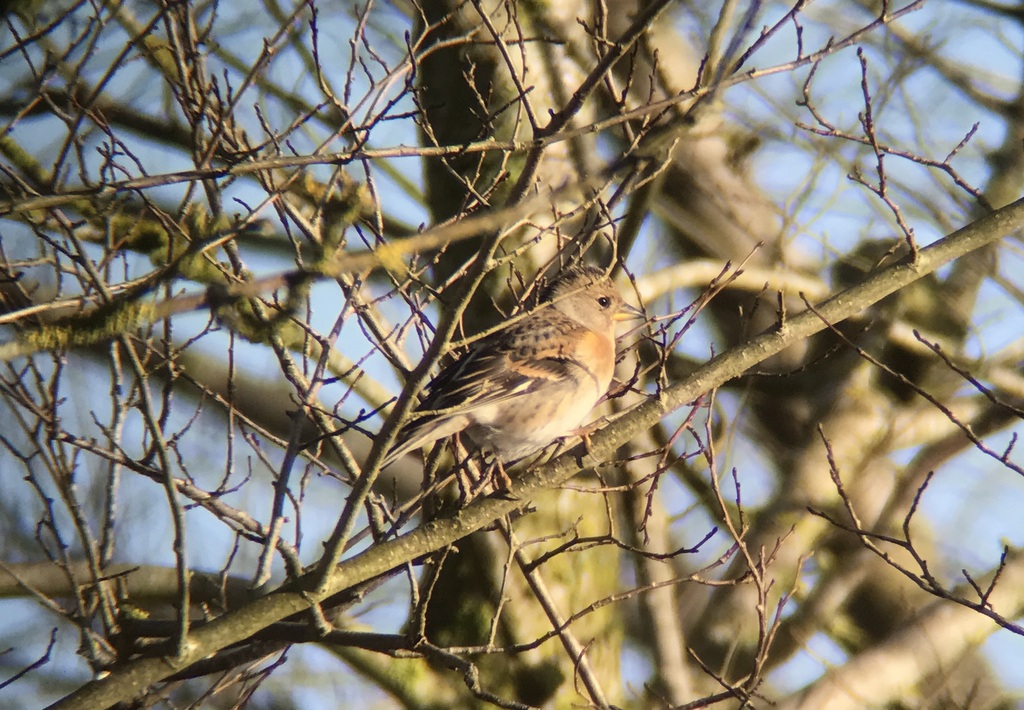
Suddenly all the birds erupted from the crop and flew round calling. We looked across to see a Sparrowhawk, a small adult male, flying low over the field. It didn’t catch anything, but having flushed everything then circled up and drifted off, with bursts of fast flapping interspersed with characteristic glides.
There were a few pools behind the hedge on the other side of road, so we had a quick look to see if anything was on those. There was a surprisingly good selection of wildfowl – as well as Mallards and four Greylag Geese, there were several Teal, a couple of pairs of Gadwall and a single drake Shoveler. A Grey Heron was standing in the sunshine at the back of the water, but flew off as we walked up.
It was starting to warm up, so we headed over to see what the Goshawks were up to. We had not even got the scopes set up when a young male appeared, flying across low over the trees. We had a good look at it through binoculars, before it dropped back down out of view. Then Goshawks were on view pretty much constantly, with at least five different individuals this morning.
Next an adult male Goshawk flew low along the front edge of the wood, before disappearing into the trees and sending all the pigeons out! A few seconds later, it appeared again, circling low over the shelter belt to one side. It disappeared once more behind the trees and the next time we picked it up it came in high from behind us, dropping back towards the wood, stooping sharply at the end and disappearing into the pines.
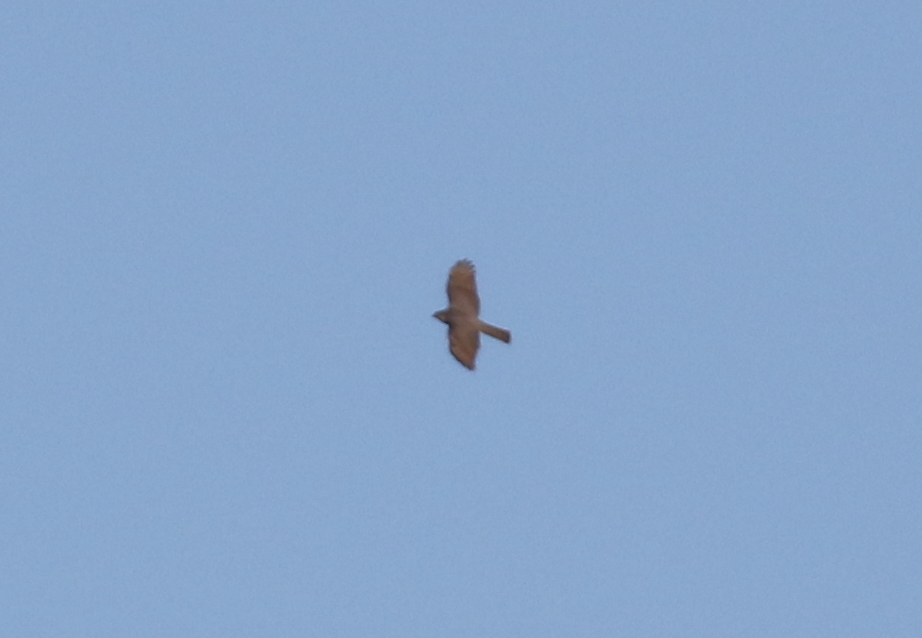
A pair of Goshawks was displaying for some time off in the distance. They were easy to see with the scope, slow flapping with exaggerated wingbeats high above the forest. Then a big adult female Goshawk appeared much closer, off to our right, circling low over the tops of the trees. It kept disappearing behind the tops, then reappearing again, never gaining any great height. Presumably it was hunting, as it never seemed to break into any display activity. Eventually it dropped down again out of view.
There were lots of other raptors on view here, even when we weren’t distracted by the Goshawks. Two Red Kites hung in the air over the strip of trees behind us. As the air warmed a little, several Common Buzzards came up and started circling. We counted at least eight today, and some of them even started displaying, swooping up and down like a rollercoaster. A Kestrel hovered out over the grass too. As well as the raptors, there were Skylarks singing and a small group of Fieldfares tchacking in the tops of trees behind us.
You could spend the whole day here, watching the comings and goings, but eventually we decided to move on. We went to look for Woodlarks next. As we pulled up by a ride into the forest, a flock of Bullfinches flew out of the brambles next to the road and disappeared behind the trees. As soon as we got out of the car, we could hear a Woodlark singing. We walked up the track a short way and looked across to see it perched high in the top of a tree out in the middle of the clearing. The Woodlark took off, but just flew across and landed again in another tree, still singing, where we could get it in the scope and have a good look at it.
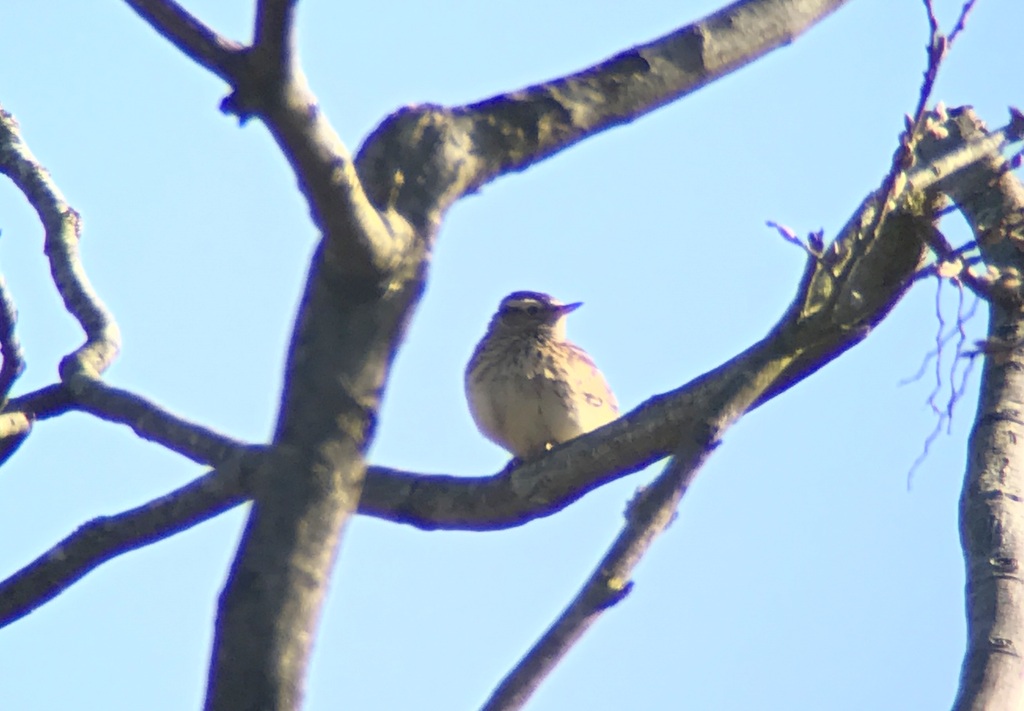
As we walked further up the track, another Woodlark appeared, perched in the top of a different tree singing. It took off as we approached and flew round singing – showing off its short tail and rounded wings, and its fluttering display flight. Eventually it dropped down into the middle of the clearing and promptly disappeared into the vegetation.
A little further along, we came across a tit flock feeding on the sunny edge of a block of pines. There were lots of restless Long-tailed Tits, accompanied by several Blue and Great Tits. A pair of Marsh Tits were feeding low down in the dry grass at the base of the trees, given away by their sneezing calls. A Goldcrest appeared, flitting around in one of the trees by the path. A smart male Bullfinch flew across in front of us and landed in the bare branches of a bush the other side.
There were a few more raptors here too, but perhaps not as much activity as we might have expected, given all the birds we had seen earlier. One more Goshawk showed itself very briefly and distantly. The Common Buzzard was much more obliging, flying across the clearing and even hovering briefly out in the middle. A pair of Kestrels showed it how it should really be done!

We walked on further round and into the forest. Several Redwings flew up from the grass by the path and disappeared into the trees. We could see several more feeding in the ivy covering a tree in the sun on the edge further in.
There were lots of tits on the sunny edge of the pines – Coal Tits, Blue Tits, Great Tits and a couple more Marsh Tits too. A flock of Long-tailed Tits flew out of the plantation into the deciduous trees the other side of the path, accompanied by a Goldcrest and a Treecreeper. We heard both Great Spotted Woodpecker and Green Woodpecker calling.
It was time for lunch now, so we headed back round to the car. Our destination for most of the afternoon was to be Lynford, but on our way we drove round via some pig fields. There were lots of gulls out on the mud among the pigs – mostly Black-headed and Common Gulls. A couple of adult Lesser Black-backed Gulls were hiding in with them and a single 1st winter Great Black-backed Gull perched on one of the pig arcs.
There were lots of Jackdaws and Rooks in the pig fields too, and a huge flock of Starlings – presumably some we would be seeing later in the day! A Red-legged Partridge was hiding in the winter wheat in the next field and a pair of Egyptian Geese flew over.
As we walked out along the path beside the Arboretum at Lynford, we stopped to have a look from the gate. There were lots of tits on the feeders, and more coming down to drink at the stone trough. Several Chaffinches were picking around down in the leaves, and a single Brambling was in with them.
Down at the bridge, there was not much seed out today. Still there were lots of tits coming to feed on the leftovers. We had particularly good views of Marsh Tit here, always a good spot for this localised species. Several Siskins were twittering in the alders above.
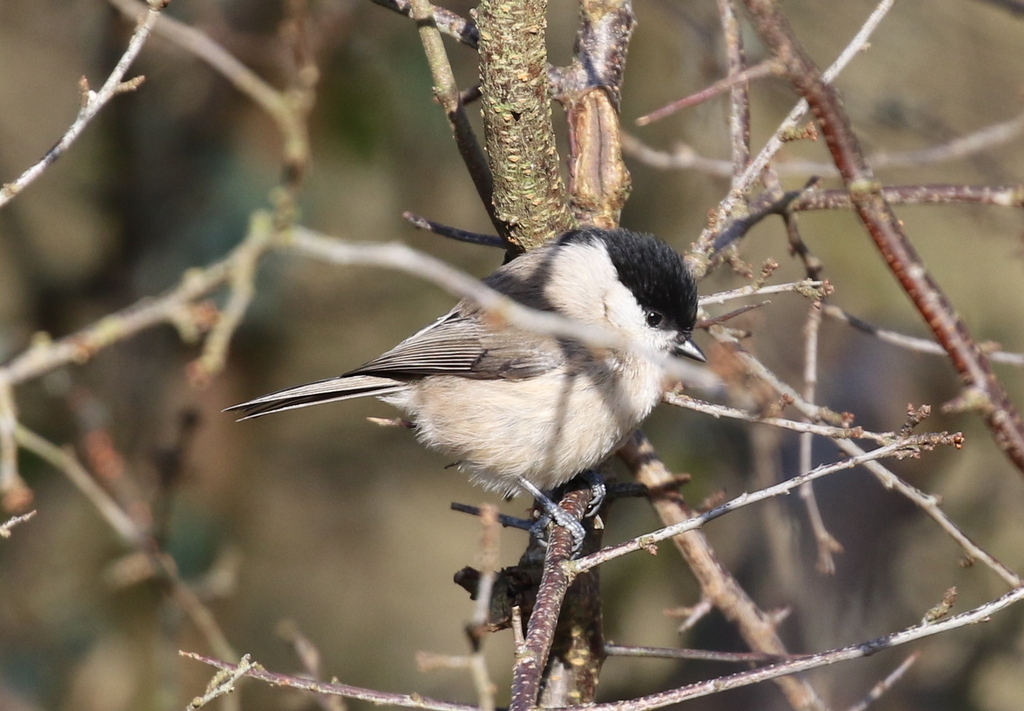
When we got to the paddocks, there was no sign of any Hawfinches feeding here today. There were several Greenfinches in the trees. A flock of twenty or so Redwings flew across and landed in the hawthorns, where we got one of them in the scope. A Mistle Thrush perched in one of the hornbeams, enjoying the afternoon sun, where it was joined by a second which flew across from the pines behind us. We could hear a Song Thrush singing.
As we walked on round the paddocks, we spotted a Hawfinch high in the fir trees, sunning itself in among the cones. It dropped down, but shortly what was presumably the same bird flew back in again and landed in the very top of the same tree. Here, we had a great view of it through the scope, noting its huge bill and head, the white tip to its tail and, when it spread its wings to stretch, the white wing bar.
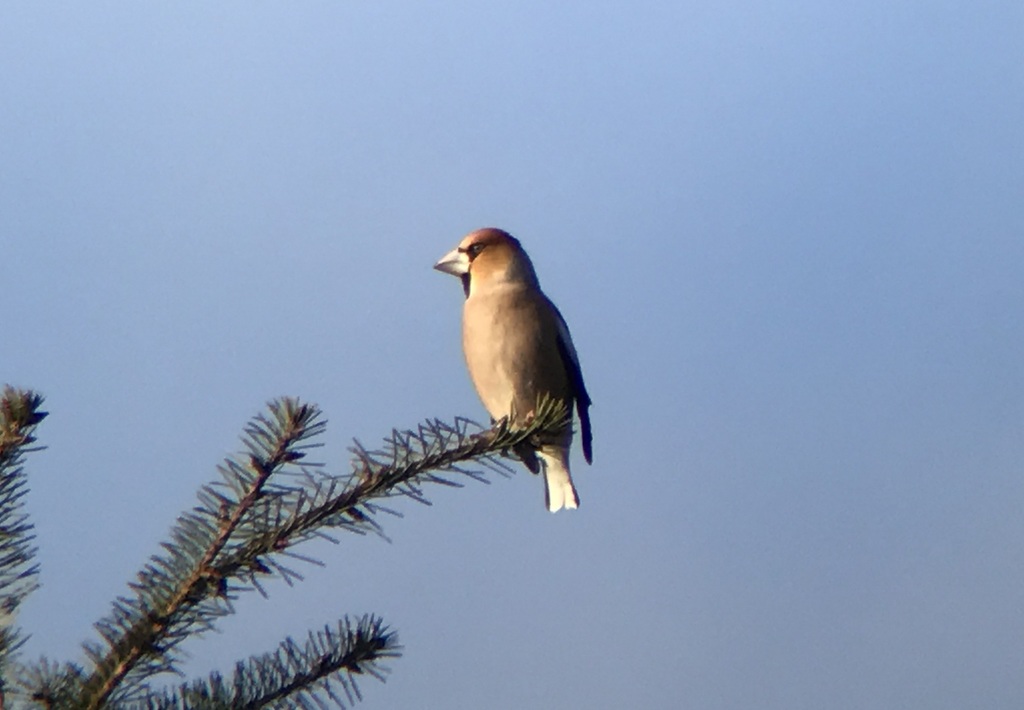
Eventually the Hawfinch flew off. There was nothing else of note in the trees here today, so we walked back and round by the lake. A Reed Bunting flew up into the bushes by the path as we passed. We heard another Song Thrush singing and eventually managed to track it down, in the alders at the back of the lake, just to complete the set of thrushes for the day!
Standing looking across to the back of Lynford Hall, we heard another Hawfinch calling from the other side of the lake. We had just started scanning the trees to see if we could find it when it flew out, across the lake and over our heads before disappearing off in the direction of the paddocks.
A Little Grebe seemed to be laughing at us, until we spotted it, wrestling with a small fish behind the island. There were several Gadwall on the lake too – the most underrated of ducks, and always worthy of a closer look. There were a couple of Greylag and a few Canada Geese too.
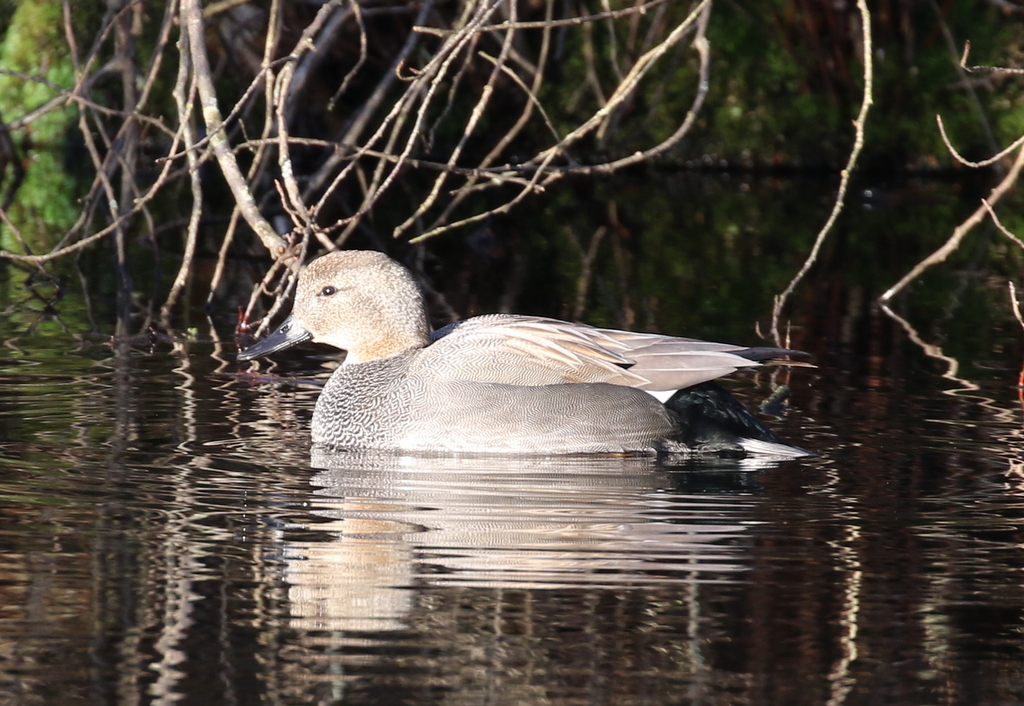
The light was starting to go now, so we set off back to the car. As we drove up towards Swaffham, we could see thousands of Starlings swirling in the skies above the town. They were fairly spread out tonight, in several different groups, and hard to count – but there must have been 20,000 birds at least!
The Starlings spent ages whirling round in the sky, flying backwards and forwards, working up the courage to come in to roost. Quite a lot went down over towards the town centre tonight, before some of the others finally started to come down into the bushes in front of us. It was mesmerising watching the flocks, like watching fireworks, bursting. in the sky as they swirled. Amazing to watch!

It was almost dark and most of the Starlings seemed to have gone in already when the ones from the town centre started to fly up again and came over to join the others in the trees in front of us, wave upon wave of them appeared out of the gloom, it seemed like it would never end. As it finally settled down again, there was an amazing amount of excited chattering from the trees. What a great way to end our first day.
Friday 16th February
After a light frost overnight, it was crisp and fresh this morning but with sunshine and blue skies, a cracking winter’s day. The winds were lighter too, compared to yesterday, so it didn’t feel so cold.
We started the day with a walk along the river. We could hear a male Grey Wagtail singing under the bridge as we approached and we then watched the pair flying back and forth over the river, perching on the brick walls and some drainage pipes.
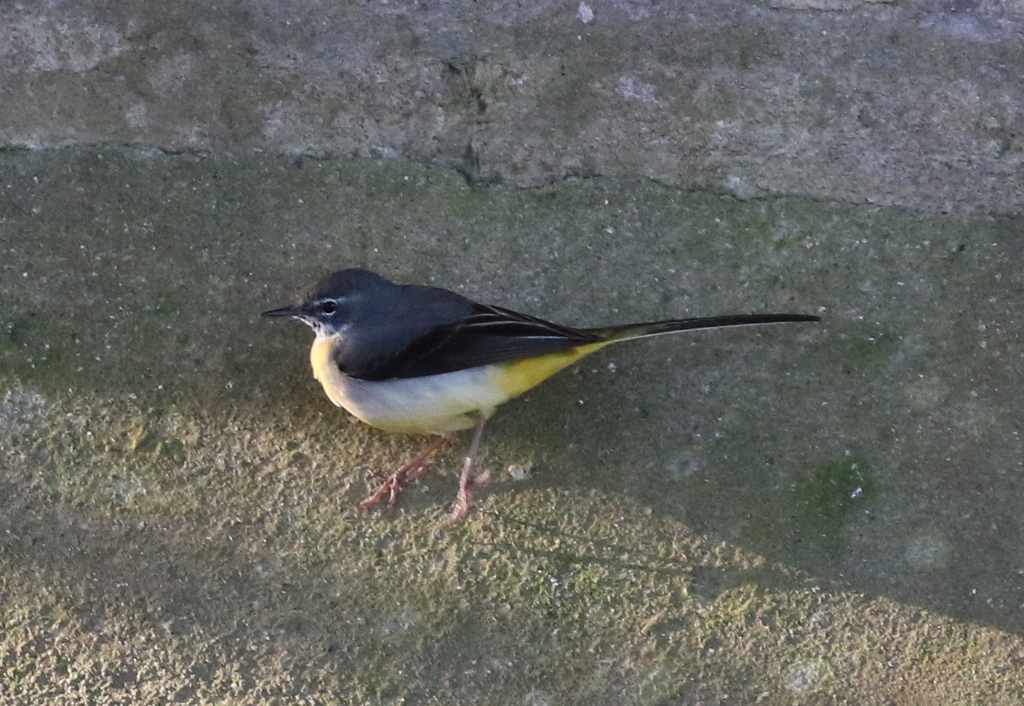
There were several Mute Swans and Little Grebes swimming and diving on the river as we walked along. We could hear a Redwing calling and looked up to see it perched high in the treetops in the sunshine. There were lots of Siskins twittering from deep in the alders, and we managed to see a couple flying back and forth across the river. A couple of Great Spotted Woodpeckers were drumming and a Green Woodpecker yaffled from the trees, always a good sign along here.
They were not the woodpeckers we were really hoping for, but as we rounded the bend in the river we could hear two Lesser Spotted Woodpeckers calling. We found a couple of people with scopes and cameras already there, and we were told one had just been showing in the tops of the trees but had dropped back down out of sight.
Thankfully, the Lesser Spotted Woodpecker continued to call occasionally and we could follow the sound. After a nail-biting few minutes when we weren’t sure whether it would show itself again, the female Lesser Spotted Woodpecker flew out and landed high in a bare poplar in front of us. We got it the scope and had a good look at it, the black and white barred back and the black crown of the female. It showed very well for us in the poplars for several minutes, flying between the trees, before it flew back into denser birches behind. We heard it call again much further in.
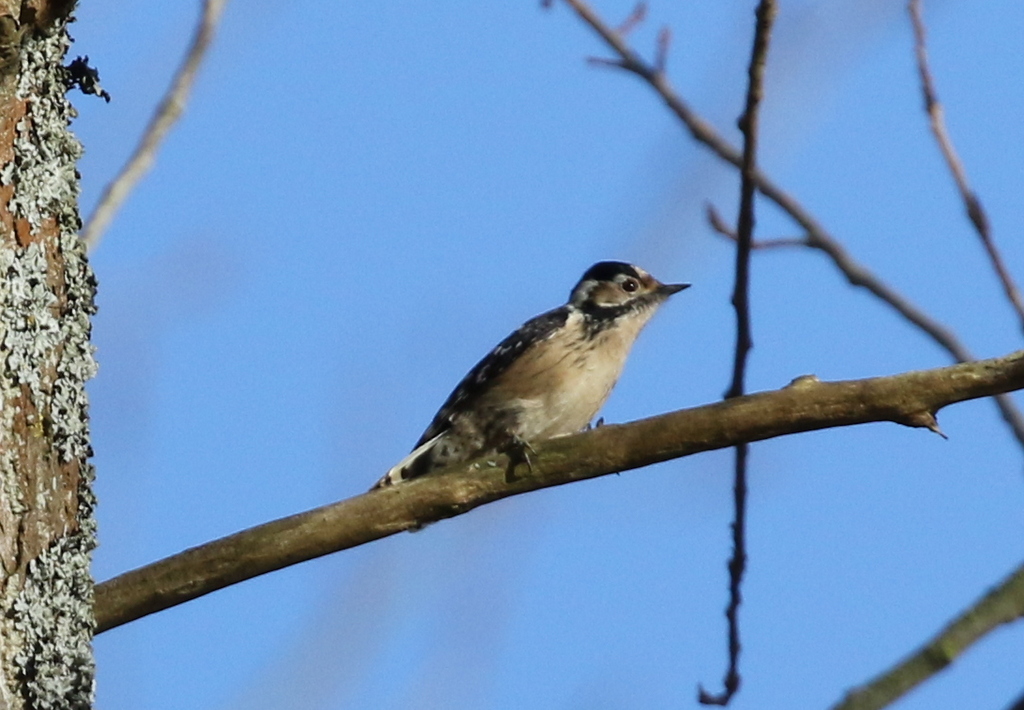
The Lesser Spotted Woodpecker then went quiet for a time. There were several other birds to look at in the interim – a Goshawk appeared through the tops of the trees before heading off over the river. There were lots of tits singing – spring must be just around the corner now – including a coupe of Marsh Tits.
Then we heard the Lesser Spotted Woodpecker call again further along the river. It was still well back in the trees, but we hurried along to see if it would come out again. We were just in time, as the female flew out over our heads, over the river, and dropped down further back in the trees the other side.
Having had such great views of the Lesser Spotted Woodpecker, we decided to walk back and try our luck with something else. On the way, we heard a Water Rail squealing from the wet reedy vegetation under the trees. A Woodlark was singing too, in the distance from a clearing in the forest beside the river.
Back at the bridge, we made our way up a small path through the trees to the churchyard. It was quiet here at first, even in the churchyard despite the sunshine on the firs here. We did head a Goldcrest singing and saw it flitting around in the tops. It was busier on the open side by the road. We found more tits and a noisy pair of Nuthatches which piped loudly at us from the trees.
What we had hoped to find here was a Firecrest and it did eventually appear. Unfortunately it was only very brief, moving through the vegetation very quickly, before it disappeared high up into the trees and we lost sight of it. Despite searching, we couldn’t find it again.
The Parrot Crossbills at Santon Downham have become very elusive again in recent days. We drove round to the car park where they sometimes come down to drink, but there had been no sign of them all morning again. There were lots of people waiting here, so we decided to try somewhere else.
The Parrot Crossbills have also been seen in the car park at St Helen’s before, so we decided to look round there. We have seen them come down to drink at the river here, so we had a walk along the bank but it was all very quiet. Given the complete absence of any sightings of Parrot Crossbills at either site this morning, we decided we would give up on them and try something else. We were just walking back towards the car, discussing what to do next, when we heard chipping calls and looked up to see 15-20 Parrot Crossbills flying past.
They seemed to be heading down towards the river, right where we had just been looking. We rushed back, and found the flock of Parrot Crossbills in the poplars. We could hear them calling and subsinging as we approached and looked up to see several perched in the branches above our heads, in the sunshine. We got the scope on them and had a great look, two red-orange males and a grey-green female. We could see their huge crossed bills and thickset bull necks.
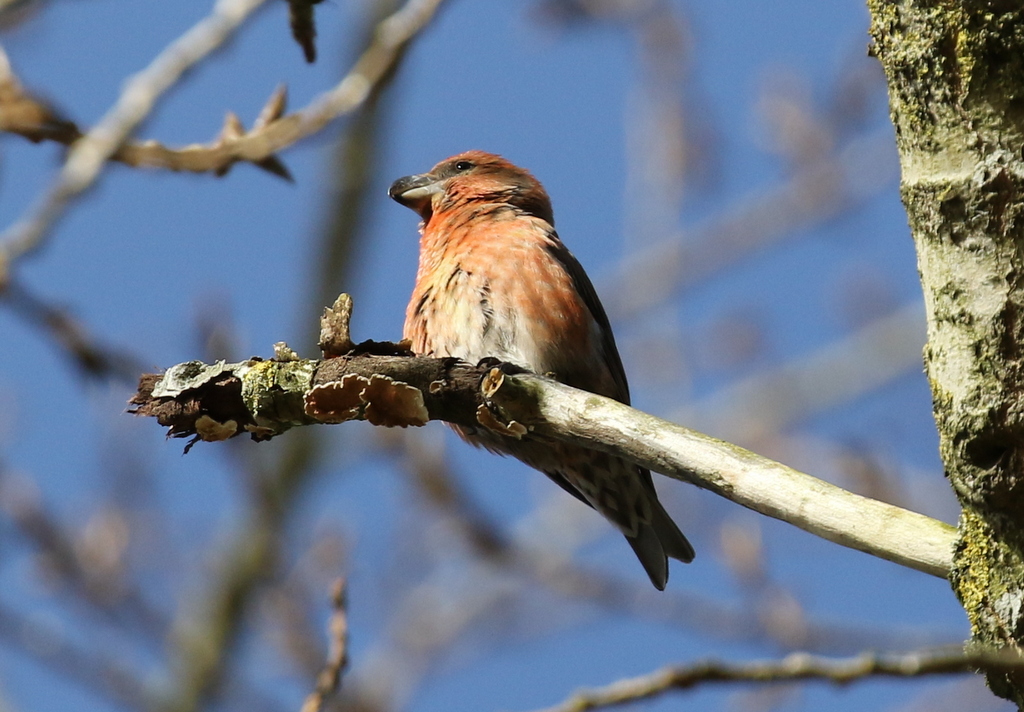
Several of the Parrot Crossbills dropped down into the alders the other side of the river. They were clearly working up the courage to come down to drink, perching in the trees around us calling for ten or more minutes. Slowly more followed the others into the tops of the alders and eventually they started to drop lower through the branches. Finally they flew down onto the river bank on the far side, two or three at a time, to drink.
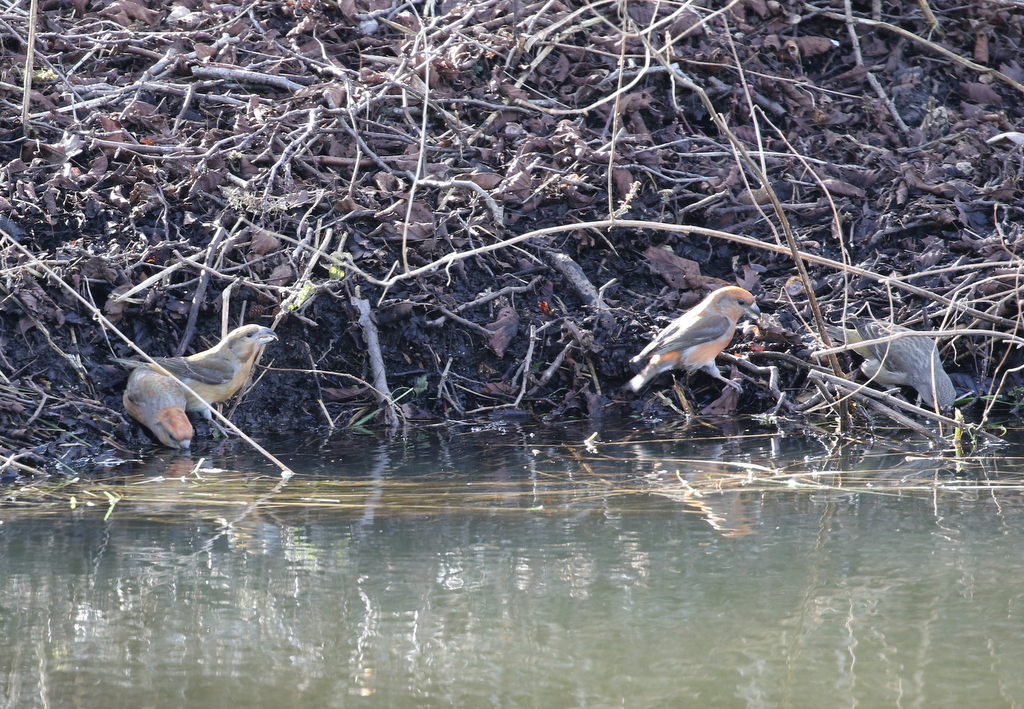
We got the Parrot Crossbills in the scope as they landed down on the far bank and watched as they each gulped down a few beak-fulls, then quickly flying up to be replaced by a couple more. What a magic moment! Eventually, when it appeared that most had drunk their fill, as quickly as they had arrived the whole flock flew off north-west. We had counted at least 15 in the trees, but there seemed to be as many as 18 as they flew off.
Well satisfied with the encounter, we headed round to Lakenheath Fen next, for lunch. After a bite to eat, we headed out to the reserve. At the feeders by the visitor centre, there were lots of tits and Reed Buntings. We decided to head out to the Washland viewpoint first.
When we got up onto the bank, the first thing we saw were two Whooper Swans out on Hockwold Washes. Through the scope, we could see the wedge shaped patch of yellow on their bills. There were lots of ducks too – Shelduck, Wigeon, Gadwall, Teal and Shoveler. A few Tufted Ducks were diving down on the river in front of us. A Curlew flew up fro the fields beyond and circled round calling.
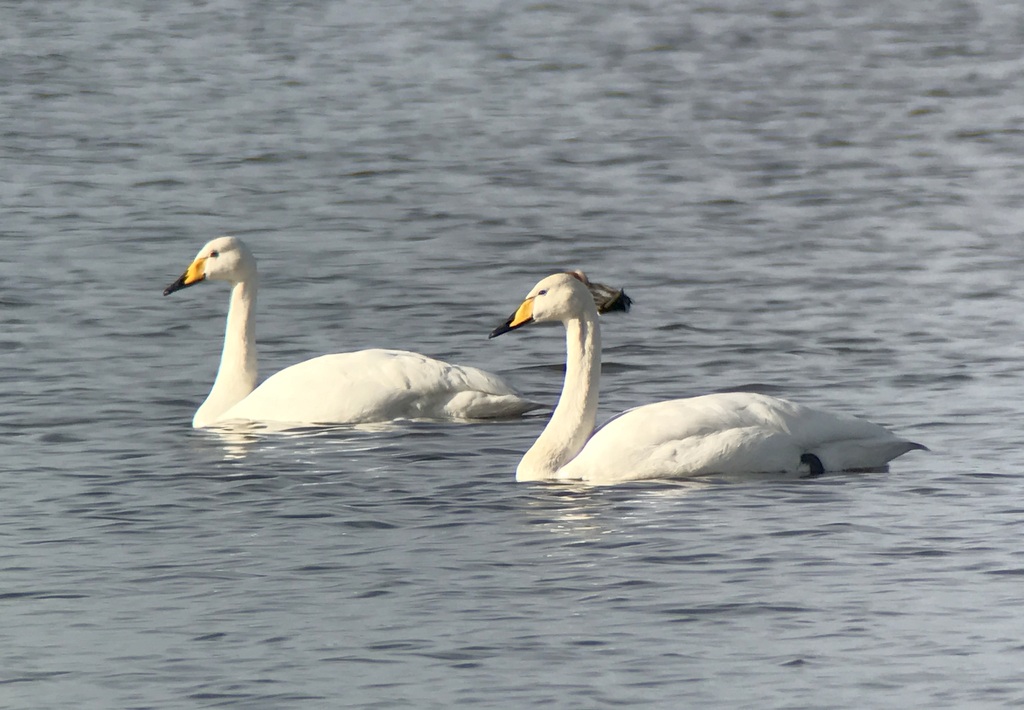
Another big white shape at the back of the Washland revealed itself to be a Great White Egret. Through the scope, we could see its long yellow dagger-like bill. As a fisherman approached along the far bank, the Great White Egret flew off east, but shortly after what we assumed was the same bird flew back west, high over the river. We watched it dropping away round the back of the poplars towards New Fen, but then when we looked back at the far corner of the Washes, there was a Great White Egret, exactly where the first had been. Could there have been two?
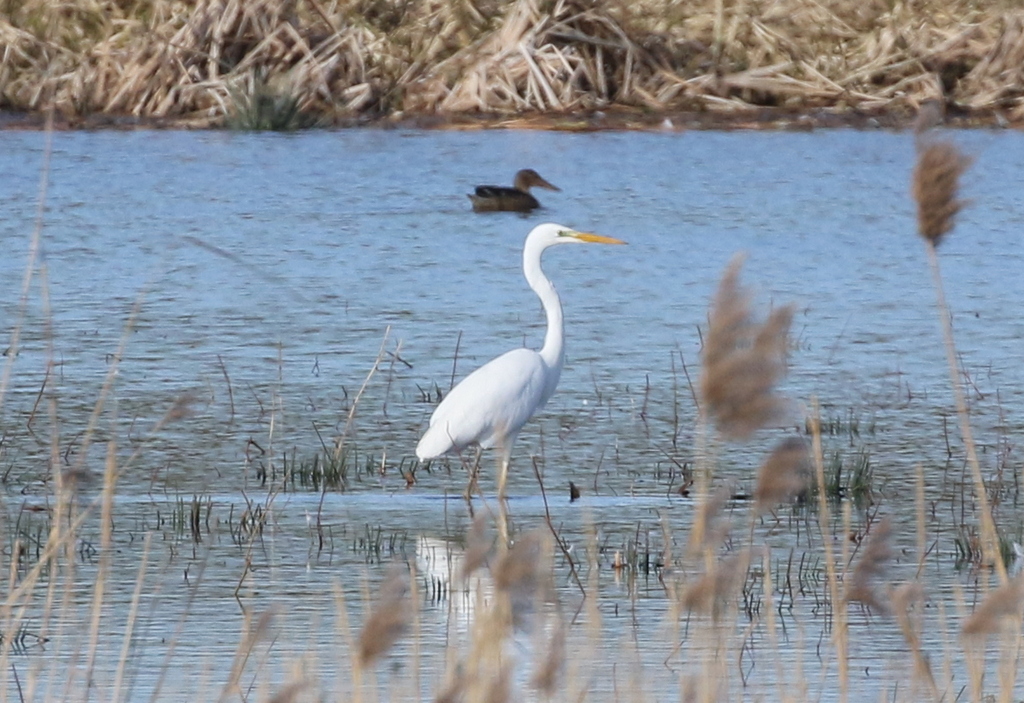
There was a family at the Washland viewpoint too and they spotted a small bird creeping around among the wet grass on the near bank of the river. It was a Water Pipit – through the scope, we could see its pale supercilium and black-streaked white underparts. Another Water Pipit flew across and disappeared into the vegetation on the other side and we heard a third calling away to our right.
We walked on west along the riverbank. We had been warned it was muddy – and they weren’t wrong(!) – but we picked our way carefully along. There were lots of birds along here, particularly a surprising number of Stonechats. We must have seen at least six, perching up on the dead thistles and seedheads in the grass. There were lots of Cetti’s Warblers too, though they were much less obliging, calling from deep in the bushes. A flock of Fieldfares flew towards us across the river and over our heads.

There were lots of Canada Geese and Greylag Geese feeding on the grass either side along the river. They were mostly sorted into separate flocks, but an odd looking bird with one of the groups of Greylags was a Canada x Greylag Goose hybrid.
A Little Egret was feeding on the edge of the river, much smaller, with an all dark bill. Then we looked up to see two Great White Egrets flying together, heading back east the way we had just come, towards the Washland. We had certainly seen two Great White Egrets now!
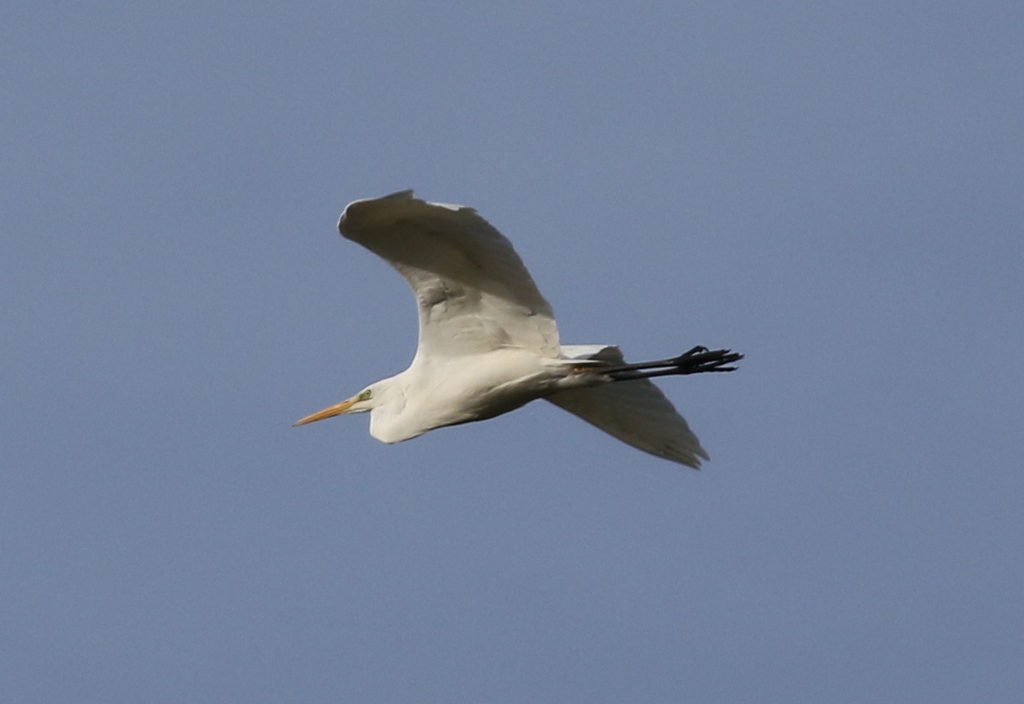
The Whooper Swans roost in the winter on the Washes but feed during the day in the fields. Once we got beyond the West Wood, we heard more Whooper Swans calling and looked across to see a family party flying in from the south. They flew across behind us, over the river, before dropping down towards the fields beyond.
As we walked on west, more Whooper Swans flew across, looking stunning in the afternoon light. It is a great sound, the honking of winter swans on a sunny February afternoon in the Fens. When we got round the bend in the river and could see across to the fields the other side, we could see a huge long line of white shapes gathered in the distance. Through the scope, we could see they were all Whooper Swans, at least 100 of them and probably much more as many were hidden behind the trees.
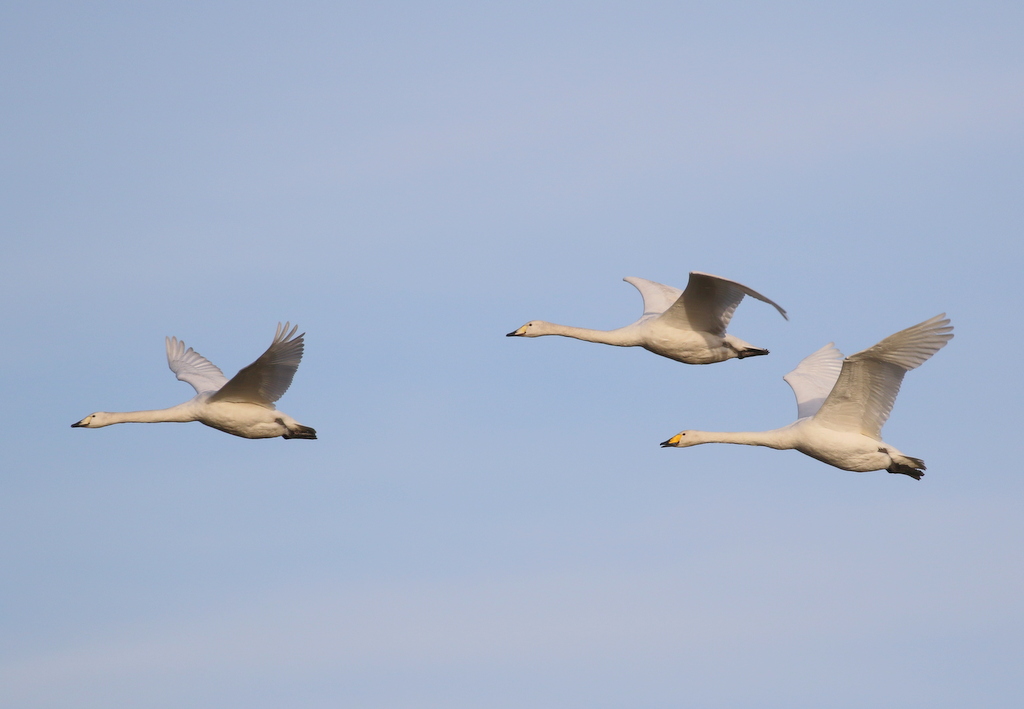
There was no sign of the Cranes on the far side of the river today, but it was possibly just too disturbed over there now. A couple of vehicles were driving up and down the track and we could see a man pigeon shooting, tending to his decoys on the edge of the area where the Cranes often like to feed. A distant Grey Heron was not the right shape or shade of grey!
Another Great White Egret flew up from the marshes across the river – presumably a third bird, as we had watched the other two flying off the other way. There were lots of Lapwings in the fields and three distant Roe Deer too. A Chiffchaff called from somewhere in the reeds nearby.
On the walk back, we cut in across the reserve. We had a sit down at the Joist Fen Viewpoint, a quick rest before the long return journey. It was a glorious winter’s afternoon, still and delightfully tranquil just sitting and looking out across the vast expanse of reeds (at least the F16s from Lakenheath were not flying overhead at that stage!). Several Marsh Harriers quartered low over the reeds and three Common Buzzards circled up over the trees.
It would have been very easy just to sit and watch the reeds and contemplate for hours, but it was getting on now so we reluctantly tore ourselves away. As we walked back along the path, flocks of gulls were flying overhead, heading off to roost. A female Kestrel perched up in the poplars in the late sunshine, but almost every time we got within range and lifted the cameras, she flew off a short distance, refusing to be photographed!

Back at the Visitor Centre, a Bank Vole was scuttling around under the feeders. It hid in a hole in the vegetation and darted out repeatedly. Then it found a discarded crisp on the ground and hauled it back into the hole. That was the last we saw of it – presumably it was enjoying the crisp!
It was time to head for home now. It had been a great couple of days in the Brecks, with some fantastic weather and some exciting birds, all the best the area has to offer at this time of year.
















